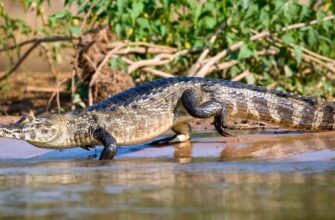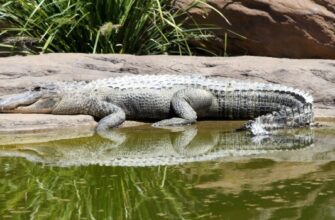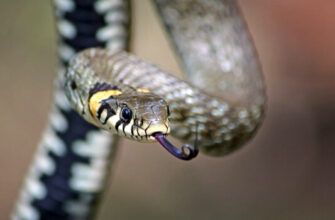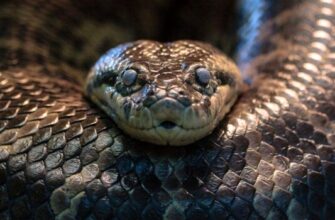Cobra — a large snake with an unusual appearance and high poisonousness, are one of the brightest representatives of their species. They are called cobras. It usually means real, collared, king cobras – the most poisonous reptiles. Today there are about sixteen varieties of such snakes.
Origin of the species and description
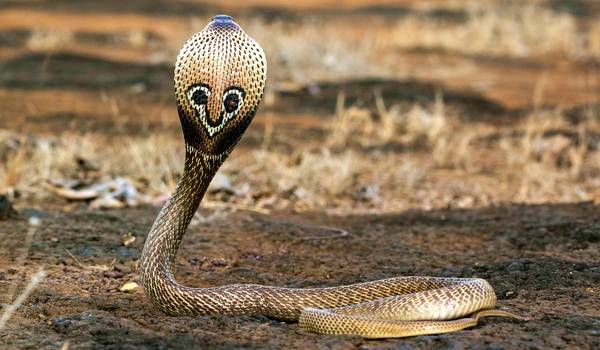
Photo: Cobra
Cobra is the common name for a whole group of snakes. They all belong to the same family – Asps. Most of these reptiles belong to the real genus. For the first time the concept of “cobra” arose in the sixteenth century. It was at this time that a spectacled snake met for the first time on the path of a person. She really surprised travelers with her unusual “hood”.
Interesting fact: The so-called hood appears in snakes only in case of danger. It is formed from skin folds that hang down the sides.
Representatives of the genus cobras have a strong poison. However, the bite of such reptiles is different from the bite of other cold-blooded animals. The venomous teeth of cobras are rather short. They are much smaller than those of vipers. Therefore, much more effort is required to inject poison into a reptile’s prey. At this time, the animal holds the victim in a stranglehold, preventing it from escaping until the poison is fully injected.
Interesting fact: Representatives of this genus never bite without prior warning. For this they are called noble snakes.
As already noted, there are about sixteen varieties of cobras.
Among them, it is worth highlighting the five most famous:
- Royal. This is the largest representative. King cobras are widespread in India, China, Vietnam and other countries. The length of the reptile can reach almost six meters, and its poison can even kill an elephant.
- Indian. This reptile is much smaller than the royal one. Its length does not exceed two meters. The Indian cobra has a bright color: yellow-gray, black, brown. During the opening of the hood on the snake, you can see a white pattern in the form of ring-shaped spots.
- Central Asian. It lives in gorges, near rivers among sparse vegetation. They go hunting during the day, live in small groups. There is no characteristic pattern in the form of glasses on her back.
- Egyptian. It is also called Gaia. She lives in northern Africa. Its weight is about three kilograms, and its length is two meters. It has a narrow hood, a solid color – various shades of brown.
- Ringed water. This animal can reach a length of almost three meters. The back of the reptile is colored yellow-brown with periodic light stripes. The main diet of the ringed cobra is fish, but sometimes it eats toads and frogs.
Appearance and features
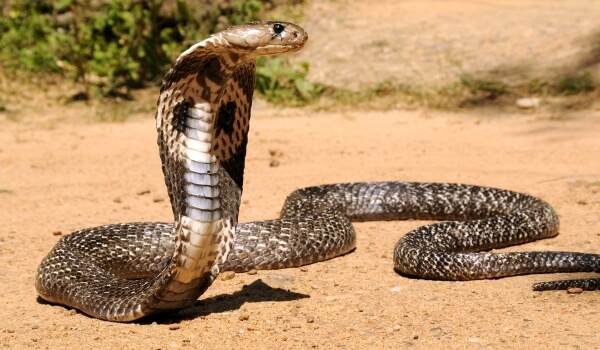
Photo: King Cobra
Cobras are nature’s most beautiful creatures, despite the danger they pose. Their appearance is very expressive, memorable. The length of such animals ranges from two to four meters, depending on the species. Weight can reach six kilograms. However, larger samples are also known to mankind. For example, in one of the zoos in London, a reptile 5.7 meters long lived for a long time.
This deadly snake can develop great speed, is agile, despite its large size. The color of her skin can be olive, green, black, brown, light yellow. Stripes are usually placed on the back, specific spots resembling glasses.
Video: Cobra
Males can be distinguished from females even by size. The males are much larger. The mouth of such reptiles can stretch to enormous sizes. This opportunity allows the animal to feast on prey of different sizes. In front of the mouth are two pronounced sharp fangs. It is through them that channels with poison pass. Another distinctive feature of cobras is the hood.
The hood has one clear purpose – scaring off rivals, enemies. If the snake demonstrates it and hisses menacingly, then some animal or person is too close. For a greater demonstration of its readiness to bite, the reptile may begin to rush towards the enemy. Such a ritual usually works brilliantly – the snake is left alone. But sometimes the cobra has to fight.
Where does the cobra live?
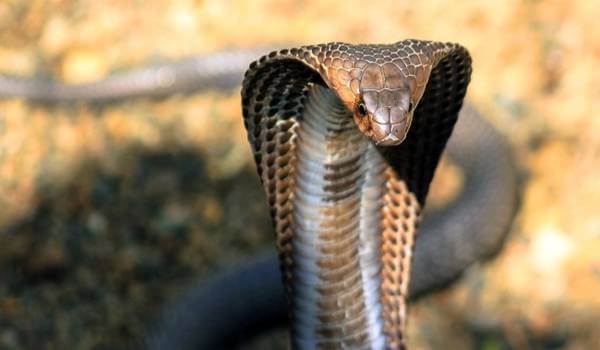
Photo: Cobra
Representatives of the cobra species are very thermophilic. They cannot live where there is snow cover. However, there is an exception. The Central Asian species lives in the north of Tajikistan, Turkmenistan, Uzbekistan. There, the ambient temperature in autumn, in winter is quite low and almost the entire territory is covered with snow.
The main habitat of such reptiles is the countries of Asia and Africa. In Africa, they are found everywhere, throughout the mainland. Asps also live in the Philippine, Sunda Islands. Representatives of this species cannot be found in Europe, Russia, Ukraine.
Reptiles put forward a number of requirements for their home:
- warm climate;
- availability of suitable food ;
- remoteness from cities, people.
Cobras prefer to settle in arid, desert places. They live in semi-deserts, savannas, deserts, tropical forests. A small population is also found in the mountains. However, only up to a height of two thousand four hundred meters. Reptiles do not climb higher.
Interesting fact: Cobras prefer to live in the wild. Then they can live for about twenty years. In the conditions of the city, too many dangers lie in wait for a poisonous snake.
In tropical forests, reptiles do not hide in bushes or under rocks. They are quite active: they can swim, climb trees. There is a separate species of cobras that spend most of the day in the water, where they hunt. They mostly live near rivers.
What does a cobra eat?
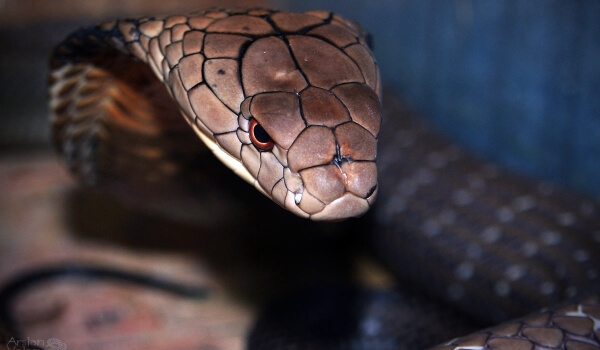
Photo: Cobra Head
Reptiles get food mainly in the daytime. Most representatives are predators. Their main diet consists of small rodents (vole mice) and amphibians. They prefer to feed on toads, frogs, lizards and even some other types of snakes. Their food is often smaller reptiles, even poisonous ones. The king cobra feeds exclusively on other reptiles.
Also, representatives of this group are not averse to eating birds. Ground-nesting birds are chosen as food. Some cobras eat fish that are caught in rivers. A small part of the snakes do not disdain even carrion, other people’s eggs.
Interesting fact: Cobras have a Jacobson organ. Thanks to him, they have a very developed sense of smell. A sharp sense of smell allows reptiles to easily smell prey in almost any conditions, even at night. Therefore, some snakes hunt at night, and during the day they rest in trees or in some secluded place.
Reptiles first wrap their future food around their whole body, and then kill them with a bite. The poison of these animals is very strong and acts almost instantly. Time is required only for the introduction of the toxin into the body of the victim, so the cobras keep their prey in their teeth for a long time, allowing the poison to completely penetrate inside.
Peculiarities of character and lifestyle
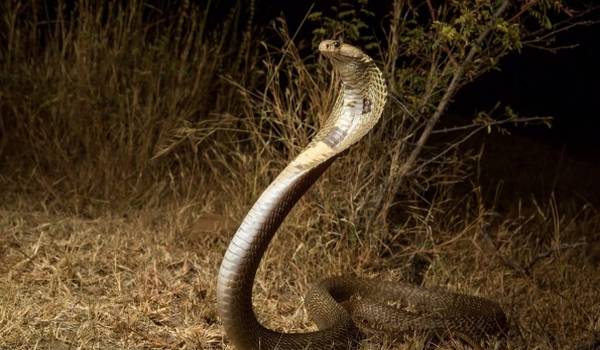
Photo: Animal cobra
The way of life of cobras is similar to the way of life of almost all reptiles. They prefer to live alone. The only exception is the king cobra. During the mating season, representatives of this species form strong, long-term pairs. These animals are most active during the day. They are not afraid of high temperature, lack of moisture. Cobras are resistant to overheating. Reptiles lead a mobile lifestyle: they swim, crawl on the ground, mountains, trees.
The nature of reptiles is quite calm, although in the minds of most people these animals are very aggressive. This is an erroneous opinion. Reptiles of this group are a little phlegmatic, rarely show aggression without a reason. This character makes deadly snakes malleable to training. They are easy to control with a detailed study of the behavior of the animal.
Cobras hunt in two ways:
- By biting the victim. Through a bite, poison is injected into the opponent, which after a while leads to death.
- Shooting poison at prey. This method of hunting is inherent only to some members of the group. In particular, the Indian cobra. She is considered the most accurate shooter. Poison flies out of the mouth under a certain pressure. The reptile can fire several shots at once, which greatly increases the chances of hitting.
Social Structure and Reproduction
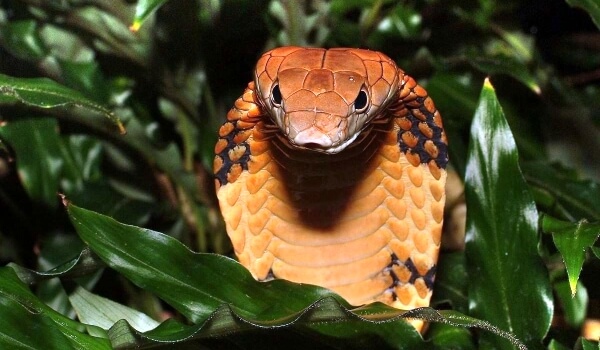
Photo: Cobra
The breeding season for cobras is in January-February, or in the spring. In winter, Indian cobras prefer to breed, in spring – Central Asian ones. Eggs are laid a few months after mating: in April, May, or in the first two months of summer. The level of fertility for each representative of the species is different. On average, the number of eggs ranges from eight to seventy at a time.
Eggs are laid in secluded places. Most often, these are crevices in stones or a small pile of fallen leaves. There are cobras that give birth immediately to live cubs. It’s about a collared snake. This reptile is capable of reproducing up to sixty individuals at a time. The females guard the clutch. Some representatives of the group not only protect, but also equip a cozy nest for future offspring. Males also take an active part. They stay with their chosen one until the offspring hatch.
During the development of offspring in eggs, some representatives of cobras show aggression. For example, Indian, king cobra. They are very active and aggressive in driving strangers away from nests. In case of great danger, they can unpredictably attack enemies, even a person. Snakes are born completely independent. At the very beginning, they produce a little poison, so young individuals hunt mainly small prey. Even some insects can become their food.
Natural enemies of cobras
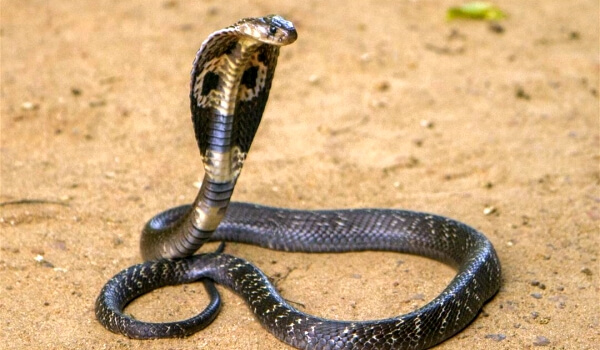
Photo: King Cobra
Even deadly animals have enemies. Cobras are no exception. They are especially at risk immediately after hatching. Young individuals are hunted by other snakes, monitor lizards. The poison of the young is not so strong, so the reptiles cannot defend themselves. Enemies of adult reptiles are meerkats, mongooses. These animals are very clever and cunning. They do not have immunity to snake venom, but they skillfully cope even with large reptiles. Meerkats, mongooses first distract the snake, and then bite it in the back of the head. This bite is fatal to the animal. It is almost impossible to escape from a mongoose or a meerkat.
Interesting fact: Many adult cobras are killed by cars. They randomly appear on the tracks. When meeting with a car, the reptile does not run away, but tries to scare it away. As a result, it turns out to be right under the wheels of the vehicle.
To protect against natural enemies, cobras have a number of adaptations. They stand in a frightening stance and inflate their “hood”, emit a menacing hiss, and some species can play dead.
Population and species status
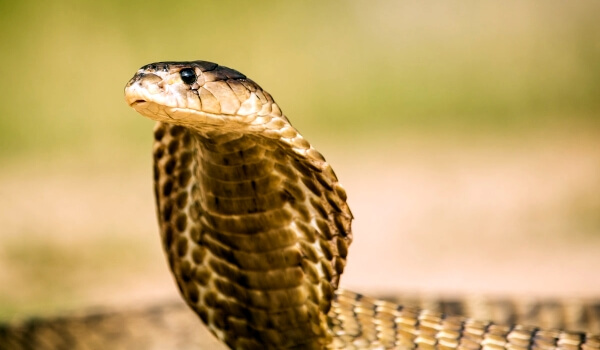
Photo: Cobra animal
The population of most cobra species in nature is considered to be gradually or moderately declining. Snakes live long only in wild conditions: deserts, savannahs. Tracking their numbers is not easy, so there is no exact data. Only the Central Asian cobra is listed in the Red Book. The number of such reptiles is quite low and is still declining.
Cobra Conservation
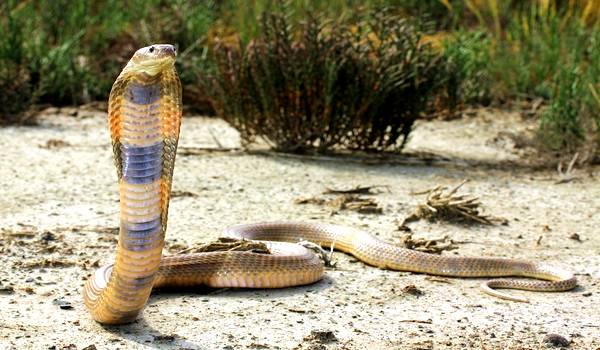
Photo: Central Asian cobra
The number of the Central Asian cobra in nature is low. It has been listed in the Red Books of many countries since 1983. The reason for the extinction of such reptiles is the rapid destruction of their habitats. Individuals living in river valleys and foothills are under great threat. Habitats are being destroyed by man as a result of intensive development of the territory.
From 1986 to 1994, this species of cobra was considered endangered. Now the status of the species is uncertain, since there is no exact data on the number of populations. Central Asian cobras are under protection, scientists are studying in detail the lifestyle and breeding characteristics of such reptiles.
Cobra is the name of a whole group of large, deadly snakes with a characteristic external feature – a small “hood”. The conservation status of these animals is in a state close to threatening. Therefore, these reptiles need protection, especially its individual representatives – Central Asian cobras.

